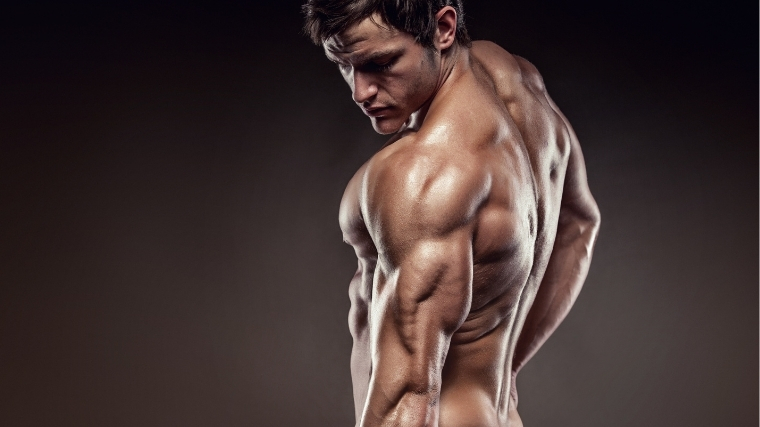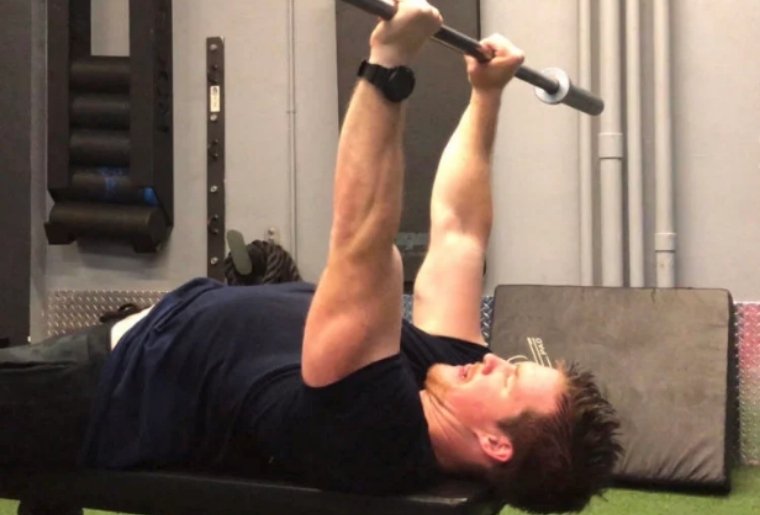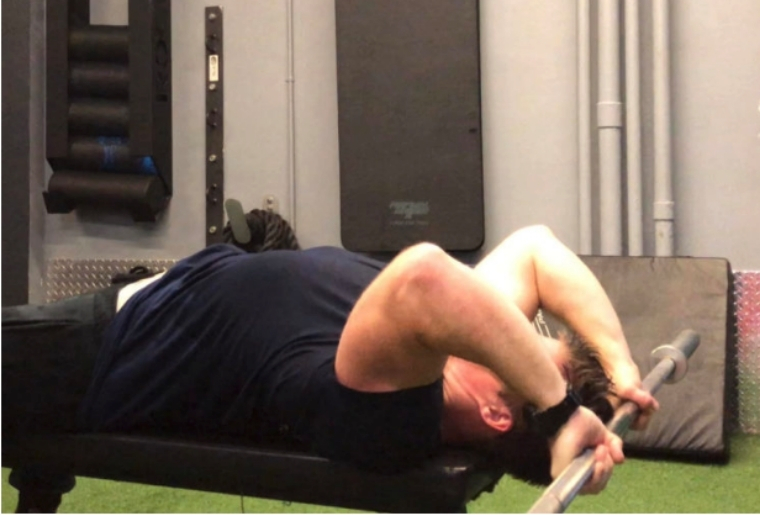How to Build Offensively Large (and Strong) Triceps With Skull Crushers
Your triceps make up two-thirds of your upper arm, and are involved in overhead presses, bench pressing, and other pushing exercises. If you want to build an impressive pair of arms while improving your upper-body strength, then you cannot neglect your tris.
The skull crusher is one of the best exercises for improving your triceps. Anyone from seasoned powerlifters, who want to improve their bench, to bodybuilders looking for more size, to general gym-goers who want a solid pump — it’s a triceps exercise for the people!
Below, we dig deep into the skull crusher to give form tips, outline benefits and provide alternatives and variations to best suit your training needs.
- How to Do Skull Crushers
- Skull Crusher Sets and Reps
- Common Skull Crusher Mistakes
- Skull Crusher Variations
- Skull Crusher Alternatives
- Muscles Worked by Skull Crushers
- Benefits of Skull Crushers
- Who Should Do Skull Crushers
- Frequently Asked Questions
How to Do Skull Crushers
Below is a step-by-step guide on how to properly set up and perform the skull crusher using a barbell.
Step 1 — Align Your Wrists and Shoulders
Start by lying down, back first, on a sturdy workout bench. The barbell should be locked out at the top position, with your hands set about shoulder-width apart. The width of your grip can vary based on flexibility and comfortability.
Coach’s Tip: The key is that you should feel that you can flex your upper back muscles and squeeze your shoulder blades together.
Step 2 — Lower the Barbell
Begin to lower the barbell towards the forehead (hence the name, skull crusher). It’s important to keep your elbows actively tucked in. If your elbows flare out a little, that’s okay, but too much flare may deactivate your triceps.
Coach’s Tip: Squeeze the barbell — hard. When you actively grip the bar, your other muscles will engage, making it easier to maintain good form throughout the exercise.
Step 3 — Stretch Your Triceps
Once the bar is at your forehead, lower your shoulders and roll your arms back so the bar is behind your head. At this point, you should feel the entire back of your arm engage and stretch intensely.
Coach’s Tip: Don’t haphazardly let the bar drop behind your head. Control it. Slowly lower it past your forehead and behind you until you feel that stretch.
Step 4 — Stay Tight and Lift
After you’ve held the bottom position of the lift for a beat, drive the bar back up, reversing the path you took to lower the bar. You should keep your elbows tucked throughout the lifting (or concentric) phase.
Coach’s Tip: Aim to follow the same path you took to lower the bar. This will ensure a smoother lift and help prevent you from jerking the bar out of alignment.
Skull Crusher Sets and Reps
Fortunately, the skull crusher isn’t as intricate as the squat or deadlift. As such, you don’t need complex programming to reap the benefits. Since it is an isolation exercise, your programming options can be somewhat limited, but that doesn’t mean skull crushers aren’t versatile.
- For Muscle Growth: 2 to 4 sets of 8 to 12 reps at a challenging but manageable weight.
- For Endurance: 3 to 4 sets of 15 to 20 reps with a light weight and limited rest.
- For Beginners: 3 sets of 8 reps with a weight that allows you to focus on your technique.
Common Skull Crusher Mistakes
It may seem foolproof since you’re only working one muscle, but the skull crusher can easily go awry. Make sure you’re sidestepping these common errors if you decide to include them into your program.
Lifting Too Heavy
No exercise is intrinsically dangerous, but the skull crusher does place a high degree of tension on your wrists and elbows. Furthermore, the setup of the movement can make it difficult to safely exit the set if things go wrong, depending on where you hit failure.
For these reasons, the skull crusher isn’t really a lift you should focus on using maximal weights with. You’ll find you get plenty of triceps stimulation from a moderate load and a solid muscular contraction.
Not Respecting Your Anatomy
There’s no universal technique for the skull crusher — everyone has different shoulders, wrists, and elbows. In the event that a straight barbell is painful or cumbersome on your joints, there’s no need to slog through using one.
A cambered bar, or even dumbbells, may allow you to perform the exercise much more comfortably and in a way that better aligns with your personal structure.
Skull Crusher Variations
If you’re in the mood to switch things up, you can make a few small tweaks to the skull crusher and see some massive differences in the kind of stimulation and gains you receive.
Dumbbell Skull Crusher
Dumbbell skull crushers are done similarly to the standard barbell version, however, you can attack the triceps unilaterally. This can be beneficial for lifters who may have muscle imbalances or coordination issues. Additionally, this may allow for a deeper elbow flexion angle, which may improve muscle development.
Incline Skull Crusher
The incline bench skull crusher variation can be done with any loading (barbell, dumbbell, kettlebell, etc.) and is set up with the bench at a slight incline. By adding the incline, you can slightly increase the stretch on the triceps and hit the muscle from slightly different angles.
Skull Crusher Alternatives
It’s totally possible that the skull crusher just isn’t right for you. Whether you lack the proper equipment, have lingering elbow issues, or simply don’t enjoy the movement, you can still blast your triceps in a similar fashion by turning to some reliable alternatives.
Close-Grip Bench Press
The close-grip bench press is a bench press variation that targets the triceps and chest by narrowing the grip width on the barbell. In doing so, you must tuck your elbows in, which will kick up the level of triceps engagement. You can swap in some close-grip work in lieu of your standard bench press programming to prioritize triceps strength and size.
Dip
Dips are a great mass building exercise for the triceps, chest, and anterior shoulders. You can do them with your own bodyweight or strap on a dipping belt to add weight and overload the target muscles even more.
Overhead Triceps Extension
The overhead triceps extension can be done with a dumbbell, a barbell, an EZ-bar, or — especially — on a cable machine. This exercise targets the similar segments of the triceps that the skull crusher does and, if you use a cable machine, may be less painful on your joints if you’re sensitive to working with free weights.
Muscles Worked by Skull Crushers
The skull crusher is a single-joint exercise that specially targets the triceps. Unlike other triceps movements, like close-grip bench press and dips, which recruit multiple muscles, the skull crusher primarily hits the triceps. That said, there’s another important — and often overlooked — muscle group that benefits.

Triceps
The triceps are responsible for elbow extension, which is a factor in most pressing movements (bench press, overhead presses, push-ups, dips, overhead stability, etc.). The skull crusher isolates the triceps by having the lifter perform deep elbow flexion while stabilizing the shoulder and wrist joints.
Shoulder Stabilizers
While the shoulder muscles themselves are not as engaged, the scapular stabilizers and rear deltoids are working diligently to stabilize the shoulder socket to allow the lifter to remain in a fixed position. By not allowing shoulder movement, the lifter can force the elbows to flex to acquire necessary ranges of motion, increasing the demands on the triceps to extend the elbow joint fully.
Benefits of Skull Crushers
Below are four benefits of the skull crusher that lifters can expect when implementing it into their training regimen.
Stronger Triceps
Strong triceps are key for all pressing movements and overhead stability. Powerlifters must have strong triceps to assist in locking out of the bench press. Weightlifters must perform triceps work as they are necessary for elbow extension in the receiving phases of the snatch and jerk. And strongmen who hoist logs that weigh over 300 pounds overhead need triceps strength to finish the lift. The stronger you get, the more you lift, and the more you lift, the more your triceps become a factor.
Improved Lockout Strength
The triceps are responsible for elbow extension, which is a key factor in finishing the end of the range of motion of the bench press, snatch, clean & jerk, and overhead press. Most power and strength athletes will see improvements in lockout performance with added triceps strength and hypertrophy work (assuming they are perfecting any technical faults resulting in press outs).
Healthier Elbows
Healthy joints often come from proper training volume, technique, and increasing muscle hypertrophy and force production so that volumes and loading can be absorbed by the muscles themselves rather than on the tendons, ligaments, and joints.
Stronger triceps (along with using proper form) is key to increasing pressing performance and minimizing overuse injury to the joints and connective tissues.
Bigger Arms
For some strength and power athletes, bigger, leaner arms are an added goal. The triceps are roughly two-thirds of the arm, so more dedicated tricep work could help you achieve a superior set of pipes.
Who Should Do Skull Crushers?
There’s no getting around it: the skull crusher is a versatile, all-purpose movement that belongs in the repertoire of any responsible gymgoer. That said, there are a few specific populations that undeniably get extra value from the movement.
Strength and Power Athletes
The skull crusher is an awesome accessory movement to increase triceps strength and hypertrophy. If you compete in a strength sport like powerlifting or weightlifting, you’ll need an accessory routine that bolsters your weaknesses. The skull crusher is a great choice here due to its ability to isolate a muscle that you often use as part of larger movement patterns.
Olympic Weightlifters
The triceps are responsible for overhead stability and elbow extension in the snatch and the jerk portions of the competitive lifts. By increasing triceps training by implementing single-joint exercises like skull crushers, you can build more raw strength and muscle mass (assuming there is no technical fault).
Bodybuilders
The skull crusher, while not as "functional" as other pressing movements like push-ups and dips, can be a good option for physique enthusiasts looking to increase their triceps training volume without relying on endless sets of presses or dips.
As such, skull crushers are a mainstay movement in nearly every bodybuilding pro’s arm day. They also are vital for proper elbow extension and upper body strength.
Crush Your Goals
Every gymgoer has their favorite movement for a given muscle. Some lean on push-ups to build their triceps, while others swear by the kickback. However, there’s a reason you’ll see skull crushers performed in just about every commercial or specialty gym on the planet. They work.
Triceps training is simple on the surface, but you’ve got to get the mechanics just right if you want to make the most gains possible. Luckily, with the right setup in mind, the skull crusher comes in second to none for building beefy arms.
FAQs
When should I do skull crushers in my workout?
Do skull crushers early in your arms training. The reason being that the skull crusher can be loaded up with more weight, and so you don’t to rob yourself of the potential to lift heavier by pre-fatiguing your muscles with other exercises.
Skull crushers hurt my elbows. What should I do?
Probably not skull crushers. First, if you’re experiencing any pain, you should consult with a doctor. However, a good rule of thumb is: if it hurts (and not in a typical workout way), you should steer clear. Try some cable variations, like pushdowns. These are generally a little easier on the elbow and shoulder joints.
Are skull crushers more effective when done with a barbell?
Not necessarily. The aim of this exercise, like all exercises, is to tax the target muscle as effectively as possible. If you can feel your muscle working, then it is. And if you can’t, then you need to try something else. Which exercise works best is different for everyone. If you don’t feel your tris engage while using a barbell, then try attaching a triceps handle to a cable. Or use a pair of dumbbells. Even kettlebells work. Play with it.
{"@context":"https://schema.org","@type":"FAQPage","mainEntity":[{"@type":"Question","name":"When should I do skull crushers in my workout?","acceptedAnswer":{"@type":"Answer","text":"
Do skull crushers early in your arms training. The reason being that the skull crusher can be loaded up with more weight, and so you don’t to rob yourself of the potential to lift heavier by pre-fatiguing your muscles with other exercises.
"}},{"@type":"Question","name":"Skull crushers hurt my elbows. What should I do?","acceptedAnswer":{"@type":"Answer","text":"
Probably not skull crushers. First, if you’re experiencing any pain, you should consult with a doctor. However, a good rule of thumb is: if it hurts (and not in a typical workout way), you should steer clear. Try some cable variations, like pushdowns. These are generally a little easier on the elbow and shoulder joints.
"}},{"@type":"Question","name":"Are skull crushers more effective when done with a barbell?","acceptedAnswer":{"@type":"Answer","text":"
Not necessarily. The aim of this exercise, like all exercises, is to tax the target muscle as effectively as possible. If you can feel your muscle working, then it is. And if you can’t, then you need to try something else. Which exercise works best is different for everyone. If you don’t feel your tris engage while using a barbell, then try attaching a triceps handle to a cable. Or use a pair of dumbbells. Even kettlebells work. Play with it.
"}}]}
Featured image: Skydive Erick / Shutterstock
Deja una respuesta





►Te puede interesar...